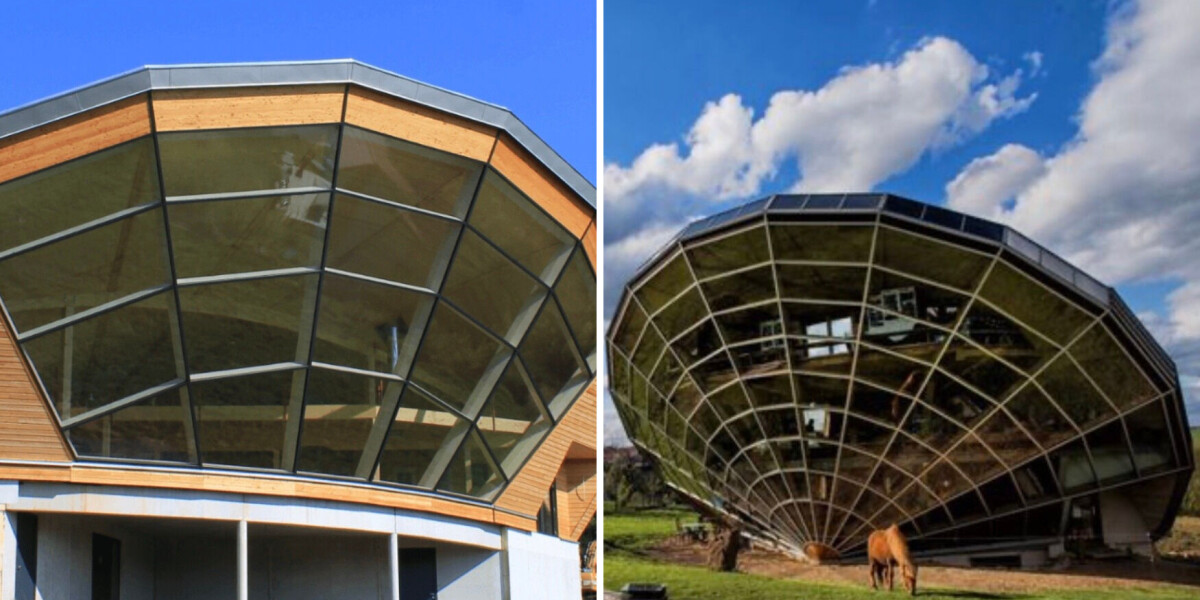
- Select a language for the TTS:
- UK English Female
- UK English Male
- US English Female
- US English Male
- Australian Female
- Australian Male
- Language selected: (auto detect) - EN
Play all audios:
THE HEAD-TURNING PROPERTIES PROMISE TO SHAPE THE FUTURE OF HOUSEBUILDING BY DRAWING ON ARCHITECTURAL PRINCIPLES FROM THE PAST A futuristic-looking dome, designed to follow the movement of
the sun through the seasons, has saved 80% on heating bills in the dozen or so houses built using the principle. It is the brainchild of Eric Wasser, 65, a furniture maker who became
fascinated by the geometry of the sun’s movements as a young man. In 1992, he drew what became his héliodome, and he patented the idea in 2000, building models. The inclination of the dome
varies according to the latitude of the building – one built on the equator would be vertical. FIRST HOUSE WAS CLOSE TO HOME In 2003, after taking first prize in the prestigious Concours
Lépine, France’s annual contest to find the invention of the year, he started to build real houses using the principle. The first comprised 200m² of living space and was constructed on his
own land. He completed it in 2010. “We have been living in it for 10 years and the results far exceed what I had hoped for,” he said. “It is warm in winter – we only use two or three
_stères_ of wood and only have to light the stove after three days without sun. “At the same time, it is cool in summer, because the inclination of the dome matched to the movement of the
sun means the house is shaded during the hottest months of the year.” As well as the large glass frontage, the house features cement floors, which absorb heat from the sun and release it at
night. READ MORE: SELF-HEATING HOMES, HOLIDAY LETS: FIVE FRENCH PROPERTY UPDATES The rest of the house is built conventionally, except that a lot of insulation is added at the start, and
corrugated steel is used for exterior cladding. The completed building boasts three floors and stands 10 metres high. ‘NOTHING NEW’ Mr Wasser is confident that his houses, and others using
orientation as a guiding principle, offer a way for people to consume less energy in future. “It is nothing new,” he said. “When you look at cities built by the ancient Greeks, the whole
place is designed for optimal heating and cooling by the sun. It is only fairly recently that people have been building without any real thought to the sun’s movement.” He added that homes
generally have not evolved with lifestyle changes: “We used to spend much more time outside but now people tend to stay indoors. “Indoors, you need light and heat, and that is what my
designs bring by using gifts of nature.” COST AND PERMISSION Around a dozen héliodomes have been built, at a cost per m² roughly double that of a simple concrete-block bungalow. Most are in
Germany and Switzerland as Mr Wasser, who lives at Cosswiller in Bas-Rhin, has contacts across the border. “There are usually no problems getting approval for a héliodome,” he said. “What
often happens is that I send the principles of my design to the architect and work with them to get planning approval.” Finding skilled craftspeople to build the dome can take time, though.
The Wassers’ own home was mostly built by himself, with help from his daughter, a mason. They used pine from woods within a 30km radius of the site. BUILDING FOR THE FUTURE Mr Wasser said
workers are often so proud of the buildings that they bring their families to the site to have a look. “When you build something like this, you are building for the future, and everything
points to the completed héliodomes being in good shape for hundreds of years,” he said. “They are incredibly low-maintenance buildings.” The domes do not have to be as large as the one he
built for himself, and can even be retro-fitted to buildings with south-facing facades. “People think they can just put in a conservatory and it will be fine,” he said. “But conservatories
on south-facing walls get baking hot in summer, whereas if they are built as an inclined dome, they are shaded in summer and hot in winter.” RELATED ARTICLES EASY-FIT FRENCH SOLAR PANELS
COULD CUT ELECTRICITY BILL BY €30 A MONTH ELECTRICITY, GAS, WOOD, OIL: DO YOU QUALIFY FOR HEATING AID IN FRANCE? OLD CLOTHES TURNED INTO HOME INSULATION AND SOLD IN FRENCH DIY SHOPS

:max_bytes(150000):strip_icc():focal(999x0:1001x2)/prince-william-3-c85ad9bd9100431da6ea225b62c8fe49.jpg)





:max_bytes(150000):strip_icc():focal(999x345:1001x347)/EUGENE-QUAYNOR-Oral-Roberts-University-01-093022-e5c3acc62eac44dba2286e34e025ee44.jpg)
